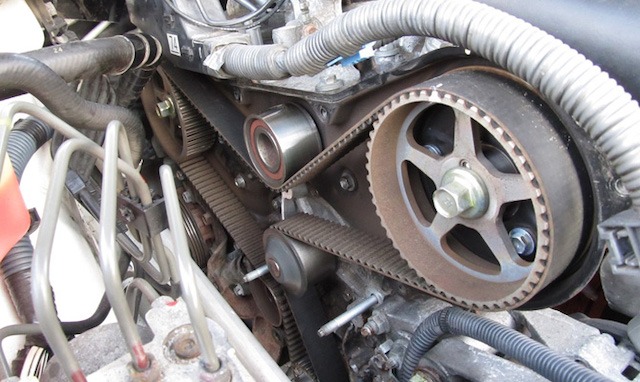Is It The Timing Belt Or The Tensioner That Is The Problem?
When a timing belt fails, it can cause serious engine issues. A good quality timing belt lasts between 60K and 100K miles. The estimated longevity depends on the manufacturer.
There are two common reasons a timing belt fails:
- Normal wear and tear
- Timing belt tensioner failure
When a timing belt tensioner fails, it can no longer provide the proper tension on the timing belt. This causes the belt to either:
- Become loose and either get misaligned or perhaps slip a tooth on a pulley
- Become too tight and stretch or break
Either way, the timing belt will become damaged too.
Replacing The Timing Belt Without Checking The Tensioner Is A Big No No

Many people see a damaged timing belt and assume that it has worn out. That’s why the go-to solution is to replace the timing belt without checking the tensioner. If the tensioner has gone bad, it’ll cause the new timing belt to fail prematurely, as well.
If you want to reduce comebacks to your shop, always check the timing belt tensioner. If a customer’s timing belt tensioner has failed, their new timing belt will fail sooner rather than later. That can lead to serious engine problems, and your shop may be on the hook for these repairs.
Whether you’ve found timing belt damage or incorrect timing belt tension, it’s worth checking the tensioner.
Signs Of Timing Belt Tensioner Failure
When a timing belt tensioner fails, it will cause catastrophic engine damage which can cost upwards of $1,000 or more based on the damage.
The biggest symptom of timing belt tensioner failure is a rough running engine. If the timing belt tensioner isn’t keeping the timing belt tight, the engine will go in and out of perfect timing. Some of the most common issues caused by tensioner failure include:
- Difficulty starting the engine
- Sluggish acceleration
- Stumbling upon acceleration
- Check engine light on
How To Check The Timing Belt Tensioner

The first thing to do when you have access to the timing belt tensioner is to check its tension. Move the pulley and see if it springs back in place. If the pulley is either stuck or loose, then the timing belt won’t have the correct amount of tension. Also check the tension of the timing belt. If it is in good shape, but doesn’t have the correct tension, the tensioner is suspect.
Next, give the tensioner a thorough inspection. Check:
- For dirt or dust build-up
- For a hydraulic oil leak
- The tensioner pulley to make sure it turns smoothly
If you’re not sure whether the timing belt tensioner has failed, replace it anyway. It’s better to be safe than sorry.
Explaining timing belt tensioner failure to a customer can be pretty tricky. This guide will help you explain it in layman’s terms.
Is The Timing Belt Tensioner Leaking?
If you find a oil leak, be sure to thoroughly clean the entire area. If the oil gets on the other pulleys, for example, it can cause the timing belt to slip off.
This is general information. Checking the tensioner is a difficult job and requires hours of labor. It is recommended this job is done by professional technician for proper diagnosis and repair.
MORE CONTENT
Stay current!
Sign up here to get the latest news
and updates on all things GMB.
Sign Up To Receive GMB News & Updates!

